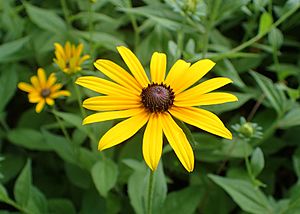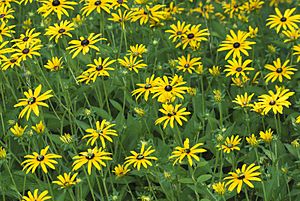Rudbeckia hirta facts for kids
Quick facts for kids Rudbeckia hirta |
|
|---|---|
 |
|
| Rudbeckia hirta flowerhead | |
| Scientific classification | |
| Genus: |
Rudbeckia
|
| Species: |
hirta
|
The Rudbeckia hirta, often called the black-eyed Susan, is a beautiful flowering plant found in North America. It belongs to the Asteraceae family, which also includes daisies and sunflowers. This plant is originally from the eastern and central parts of North America. It has also spread to the western parts of the continent and even to China. You can now find black-eyed Susans in all 10 Canadian provinces and all 48 states in the contiguous United States.
The black-eyed Susan is the official state flower of Maryland.
Contents
What Does It Look Like?
The black-eyed Susan is usually an annual plant, meaning it lives for one growing season. Sometimes, it can be a biennial (living two years) or a perennial (living more than two years). It grows to be about 30 to 100 centimeters (1 to 3 feet) tall and 30 to 45 centimeters (1 to 1.5 feet) wide.
Its leaves are mostly near the bottom of the plant and are covered in coarse, rough hairs. The plant has strong, branching stems. Its flower heads look like daisies and appear in late summer and early autumn. Each flower can be up to 10 centimeters (4 inches) across. They have bright yellow ray florets (the "petals") around a dark brown or black, dome-shaped center. This center is made up of many tiny disc florets.
Over time, people have grown many different types of black-eyed Susans. These new types come in various sizes and colors, including oranges, reds, and browns.
Why Is It Called That?
The scientific name hirta comes from Latin and means "hairy." This refers to the tiny hairs found on the leaves and stems of the plant.
People have many common names for this flower, such as:
- Brown-eyed Susan
- Brown betty
- Gloriosa daisy
- Golden Jerusalem
- Yellow daisy
- Yellow ox-eye daisy
Growing Black-Eyed Susans
Black-eyed Susans are very popular and are grown in many parks and gardens. People use them for summer flower beds, garden borders, and in pots. They are also great for wildflower gardens and for making beautiful cut flowers.
Many special types, called cultivars, have been created. Two popular ones are 'Indian Summer' and 'Toto', which have won awards for being great garden plants. Other well-known types include 'Double Gold' and 'Marmalade'.
Gloriosa daisies are a special kind of black-eyed Susan. They have much larger flowers than the wild plants. Sometimes, their flowers are even "doubled" or have different colored markings on the petals. These special daisies were first created by a scientist named Alfred Blakeslee. Gloriosa daisies are usually grown from seeds and are treated as annuals or short-lived perennials.
Symbolism and Uses
Maryland's State Flower
The black-eyed Susan became the official state flower of Maryland in 1918. It is used in gardens and at special events to show pride and affection for the state and its people.
The famous Preakness Stakes horse race in Baltimore, Maryland, is sometimes called "The Run for the Black-Eyed Susans." This is because a blanket of yellow flowers that look like black-eyed Susans is placed around the winning horse's neck. Real black-eyed Susans are not usually blooming in May when the race happens.
University of Southern Mississippi's Colors
In 1912, the black-eyed Susan inspired the school colors (black and gold) for the University of Southern Mississippi. Florence Burrow Pope, one of the university's first graduates, suggested the colors. She saw many black-eyed Susans in the pine forests and thought their black and gold colors would be perfect for the school.
Helping Butterflies
Many butterflies love the Rudbeckia hirta flower. It is a food source for the young caterpillars of several butterfly species, including the bordered patch, gorgone checkerspot, and silvery checkerspot.
Natural Mosquito Control
Dragonflies are insects that eat a lot of mosquitoes. They are attracted to the small insects that visit black-eyed Susan flowers. This means that having black-eyed Susans can help bring dragonflies to your garden, which can then help control mosquitoes!
Traditional Native American Uses
Some Native American groups traditionally used this plant as an herbal medicine for different health problems. For example, the Ojibwa people used the roots of the plant to make a soft, moist mass (called a poultice) for snake bites. They also made a liquid medicine (called an infusion) from the roots to help treat colds and worms in children.
It's important to remember that while these are traditional uses, the claims that black-eyed Susan can boost immunity or fight colds and infections are not scientifically proven.
Important Caution
If cats eat the black-eyed Susan plant, it can be harmful to them.
Gallery
See also
 In Spanish: Rudbeckia bicolor para niños
In Spanish: Rudbeckia bicolor para niños






